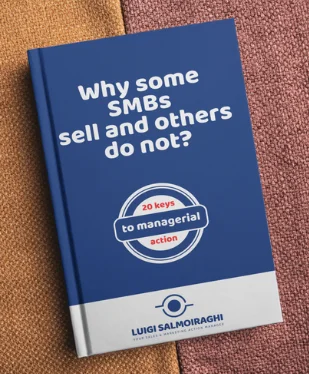

In the last year, I have had the chance to meet with some startups ready to become new unicorns on the market. Few of them offer reasonable solutions, but the majority will not succeed in this journey for a straightforward reason: they love their product while they should fall in love with the problem.
I always suggest reading Uri Levin’s book “Fall in Love with the Problem, not with the Solution.” In this book, the co-founder of Waze gives simple and practical hints on how to avoid common mistakes.
So, if you have an idea for a startup, how can you ensure your concept will succeed?
Which of your myriad ideas should you pursue?
Before embarking on this entrepreneurial journey, your pre-journey phase will be to validate three core elements, which are the critical elements for your startup success, by asking the following:
Every entrepreneur’s journey begins at a familiar crossroads. Once you’ve pinpointed the problem, the next step will be identifying who has it.
Many entrepreneurs fail in that phase. They have a personal point of view on the problem and assume everyone shares it as well. They might speak with very few friends or potential business partners who may have the issue and base their conclusion that the problem is real only on that.
Segmenting your audience is the key. By identifying specific groups plagued by this issue, you begin to narrow your focus. Engage in conversations with those individuals to grasp their perspective on the matter.
An actual problem worth solving will resonate immediately, and people will start telling you about their experience with that problem. If your audience grasps the issue within seconds of your explanation, it’s likely not their problem.
This process will unveil the various nuances of the problem. Take, for instance, the universal disdain for waiting in lines. While some dislike airport security queues, others dread the supermarket or any governmental/official service. Yet, which line truly warrants a solution?
To determine this, speak with 100 people to understand the problem. Consider two factors: frequency of use and Total Addressable Market (TAM).
While visiting the Apple store when a new iPhone is released is comparatively rare, supermarket store lines are frequently annoying. And while occasional travellers might be okay with airport security, frequent flyers certainly do.
So, how do you decide which problem to address? First, you need to hate it enough; it needs to be personal, one that you have the passion and the urge to solve, but this is not enough. A problem worth solving would be a widespread issue that occurs regularly. Such opportunities are few and far between. Most problems cater to niche markets or need to occur more frequently. Niche and painful enough are good problems to solve.
In this stage, you must determine what individuals will shell out to eradicate it. Services like valet parking and Uber Eats thrive because people pay to bypass wait times, but I’ve heard of people waiting in line for Apple stores to open to get the new iPhone, and other people are willing to pay them for that. Line-avoiding services are simple exchanges of time and money, but in reality, they are exchanges of frustration over cash.
However, it takes work to discern between potential and actual willingness to pay. While the former is a good indicator, more is needed.
Determine the potential customer base size and the value your solution could bring. For instance, die-hard Apple fans might value cutting down their wait time for the latest iPhone more than occasional travellers value a fast pass at the airport.
If your market is divided into multiple segments, focus on one aspect of the problem worth solving.
A problem”worth solving” is one in which the total addressable market (TAM) multiplied by its value is substantial and significant enough.
Then, you multiply the TAM by the willingness to pay to determine the size of the opportunity, whether it is worthwhile, and what strategy you should use.
Only then will you be ready to embark on your startup journey?
In the last year, I have had the chance to meet with some startups ready to become new unicorns on the market. Few of them offer reasonable solutions, but the majority will not succeed in this journey for a straightforward reason: they love their product while they should fall in love with the problem.
I always suggest reading Uri Levin’s book “Fall in Love with the Problem, not with the Solution.” In this book, the co-founder of Waze gives simple and practical hints on how to avoid common mistakes.
So, if you have an idea for a startup, how can you ensure your concept will succeed?
Which of your myriad ideas should you pursue?
Before embarking on this entrepreneurial journey, your pre-journey phase will be to validate three core elements, which are the critical elements for your startup success, by asking the following:
Every entrepreneur’s journey begins at a familiar crossroads. Once you’ve pinpointed the problem, the next step will be identifying who has it.
Many entrepreneurs fail in that phase. They have a personal point of view on the problem and assume everyone shares it as well. They might speak with very few friends or potential business partners who may have the issue and base their conclusion that the problem is real only on that.
Segmenting your audience is the key. By identifying specific groups plagued by this issue, you begin to narrow your focus. Engage in conversations with those individuals to grasp their perspective on the matter.
An actual problem worth solving will resonate immediately, and people will start telling you about their experience with that problem. If your audience grasps the issue within seconds of your explanation, it’s likely not their problem.
This process will unveil the various nuances of the problem. Take, for instance, the universal disdain for waiting in lines. While some dislike airport security queues, others dread the supermarket or any governmental/official service. Yet, which line truly warrants a solution?
To determine this, speak with 100 people to understand the problem. Consider two factors: frequency of use and Total Addressable Market (TAM).
While visiting the Apple store when a new iPhone is released is comparatively rare, supermarket store lines are frequently annoying. And while occasional travellers might be okay with airport security, frequent flyers certainly do.
So, how do you decide which problem to address? First, you need to hate it enough; it needs to be personal, one that you have the passion and the urge to solve, but this is not enough. A problem worth solving would be a widespread issue that occurs regularly. Such opportunities are few and far between. Most problems cater to niche markets or need to occur more frequently. Niche and painful enough are good problems to solve.
In this stage, you must determine what individuals will shell out to eradicate it. Services like valet parking and Uber Eats thrive because people pay to bypass wait times, but I’ve heard of people waiting in line for Apple stores to open to get the new iPhone, and other people are willing to pay them for that. Line-avoiding services are simple exchanges of time and money, but in reality, they are exchanges of frustration over cash.
However, it takes work to discern between potential and actual willingness to pay. While the former is a good indicator, more is needed.
Determine the potential customer base size and the value your solution could bring. For instance, die-hard Apple fans might value cutting down their wait time for the latest iPhone more than occasional travellers value a fast pass at the airport.
If your market is divided into multiple segments, focus on one aspect of the problem worth solving.
A problem”worth solving” is one in which the total addressable market (TAM) multiplied by its value is substantial and significant enough.
Then, you multiply the TAM by the willingness to pay to determine the size of the opportunity, whether it is worthwhile, and what strategy you should use.
Only then will you be ready to embark on your startup journey?



